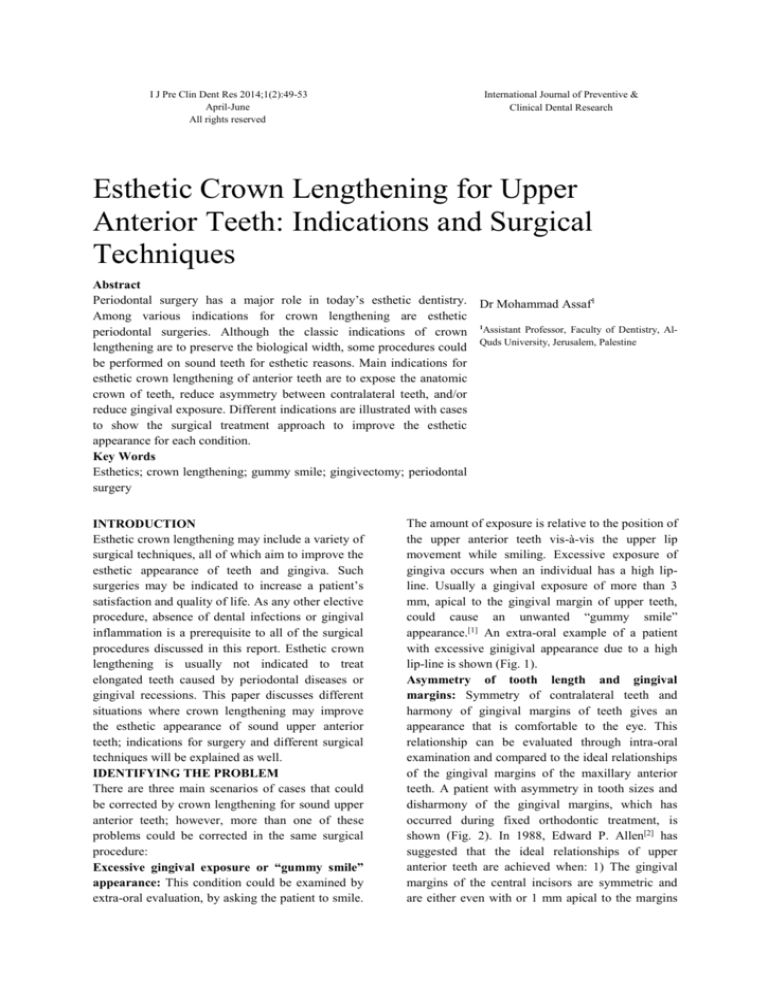
I J Pre Clin Dent Res 2014;1(2):49-53
April-June
All rights reserved
International Journal of Preventive &
Clinical Dental Research
Esthetic Crown Lengthening for Upper
Anterior Teeth: Indications and Surgical
Techniques
Abstract
Periodontal surgery has a major role in today’s esthetic dentistry. Dr Mohammad Assaf1
Among various indications for crown lengthening are esthetic
1
periodontal surgeries. Although the classic indications of crown Assistant Professor, Faculty of Dentistry, Allengthening are to preserve the biological width, some procedures could Quds University, Jerusalem, Palestine
be performed on sound teeth for esthetic reasons. Main indications for
esthetic crown lengthening of anterior teeth are to expose the anatomic
crown of teeth, reduce asymmetry between contralateral teeth, and/or
reduce gingival exposure. Different indications are illustrated with cases
to show the surgical treatment approach to improve the esthetic
appearance for each condition.
Key Words
Esthetics; crown lengthening; gummy smile; gingivectomy; periodontal
surgery
INTRODUCTION
Esthetic crown lengthening may include a variety of
surgical techniques, all of which aim to improve the
esthetic appearance of teeth and gingiva. Such
surgeries may be indicated to increase a patient’s
satisfaction and quality of life. As any other elective
procedure, absence of dental infections or gingival
inflammation is a prerequisite to all of the surgical
procedures discussed in this report. Esthetic crown
lengthening is usually not indicated to treat
elongated teeth caused by periodontal diseases or
gingival recessions. This paper discusses different
situations where crown lengthening may improve
the esthetic appearance of sound upper anterior
teeth; indications for surgery and different surgical
techniques will be explained as well.
IDENTIFYING THE PROBLEM
There are three main scenarios of cases that could
be corrected by crown lengthening for sound upper
anterior teeth; however, more than one of these
problems could be corrected in the same surgical
procedure:
Excessive gingival exposure or “gummy smile”
appearance: This condition could be examined by
extra-oral evaluation, by asking the patient to smile.
The amount of exposure is relative to the position of
the upper anterior teeth vis-à-vis the upper lip
movement while smiling. Excessive exposure of
gingiva occurs when an individual has a high lipline. Usually a gingival exposure of more than 3
mm, apical to the gingival margin of upper teeth,
could cause an unwanted “gummy smile”
appearance.[1] An extra-oral example of a patient
with excessive ginigival appearance due to a high
lip-line is shown (Fig. 1).
Asymmetry of tooth length and gingival
margins: Symmetry of contralateral teeth and
harmony of gingival margins of teeth gives an
appearance that is comfortable to the eye. This
relationship can be evaluated through intra-oral
examination and compared to the ideal relationships
of the gingival margins of the maxillary anterior
teeth. A patient with asymmetry in tooth sizes and
disharmony of the gingival margins, which has
occurred during fixed orthodontic treatment, is
shown (Fig. 2). In 1988, Edward P. Allen[2] has
suggested that the ideal relationships of upper
anterior teeth are achieved when: 1) The gingival
margins of the central incisors are symmetric and
are either even with or 1 mm apical to the margins
50 Esthetic crown lengthening
Fig. 1: High lip line with excessive gingival exposure; (a)
before, (b) after esthetic crown lengthening
of the lateral incisors; 2) The gingival margins of
the canines should be 1 mm apical to the level of the
lateral incisors; 3) A line drawn horizontally at the
level of the canine gingival margins should be
parallel to the inter-pupillary line; 4) The smile
should expose a minimal amount of gingiva apical
to the centrals and canines, and should be in
harmony with the smile line; 5) The lateral incisors
should be exposed 1.5 mm less than the length of
the centrals. He also suggested that the crowns of
central incisors and canines could be exposed to an
overall length of 11 to 12 mm to attain maximal
gingival reduction.[2]
Incomplete passive eruption or “short teeth”
appearance: Altered passive eruption may be
present on all or some of the upper anterior teeth.
Usually these patients are complaining of the
“gummy smile” appearance. Such patients are most
of the time unaware of that they have “short teeth”
till they are examined. Average lengths of anterior
teeth are 11, 9, and 10.5 mm for upper centrals,
laterals, and canines, respectively. A simple
determination of the deficiency of length of anterior
teeth could be conducted by measuring the length of
the exposed crown, using a ruler or periodontal
probe (Fig. 3). To plan for the esthetic crown
lengthening surgery for upper anterior teeth, a line
parallel to the inter-pupillary line, connecting the
anticipated buccal gingival margins of the canines
and central incisors, is drawn (Fig. 3b). This line is
supposed to meet the level of the cemento-enamel
Assaf M
Fig. 2: Asymmetry of gingival margin; (a) before, (b)
two months after esthetic crown lengthening
junction at the buccal surface of the canines and
centrals, should be no more than 12 mm from the
incisal edge of the central incisors, and no more
than 11 mm from the cusp tips of the canines.[2]
Fig. 3: Crown lengthening to expose the anatomic crowns; (a)
before surgery, (b) line connectinting anticipated gingival
margins of centrals and canines, (c) after esthetic crown
lengthening
51 Esthetic crown lengthening
Attrition of the incisal edges of teeth needs to be
compensated when estimating the cementoenamel
junction of the “worn” teeth.[3] Evaluation of the
alveolar bone level is obtained by “probing to bone”
or “sounding” under local anesthesia where the
periodontal probe is forced through the periodontal
tissues apical to the sulcus and up to the level of the
alveolar bone.[4] Conditions that favor the presence
of a thicker plate of bone (with thick, flat
periodontium) will result in a more accurate
assessment of the alveolar crest position through
bone sounding. Other cases associated with bone
dehiscence or a thin labial osseous plate (thin,
scalloped periodontium), may make identification
of the alveolar crest more difficult. This, in
retrospect, may be of less consequence since thin or
dehisced labial plates are more likely to resorb
postoperatively.[5]
Assaf M
away from the anticipated gingival margin, then
bone resection is necessary, which requires a fullthickness flap to be raised.[6] Gingivectomy could
be performed by blades or specially designed knifes
as Kirkland knife and Orban knife to make a
beveled incision, which is about 45 degrees towards
the long axis of tooth with an apico-coronal
direction (Fig. 4). Some clinicians prefer to use
diode laser instead of sharp instruments for
gingivectomy/gingivoplasty due to its advantage of
having more delicate strokes and intraoperative
hemostasis.[5]
Fig. 5: Esthetic crown lengthening using an apically
positioned flap without osseous resection; (a+b) before, (c+d)
immediately after excision, (e+f) six weeks post-op
Fig. 4: Gingivectomy using (b) surgical blade and (c)
Orban knife, and showing (d) the excised gingiva
SURGICAL TECHNIQUES
After determining the problem, the amount of
planned soft resection, and the extent to which bone
resection might be required, including the surgical
technique, can be decided. If only soft tissue
removal was needed (no bone resection) then there
are two options; gingivectomy (beveled incision) or
apically positioned flap (reverse beveled incision).
If the crest of alveolar bone was less than 3 mm
The minimal apically positioned flaps are very
practical when a small amount of the labial gingival
margin is to be removed and no bone resection is
needed (Fig. 5). They have the advantage of safely
preserving the papilla by just limiting the incision
within the mesial and distal buccal line angles of the
tooth (Fig. 5d). Another advantage is that further
bone resection could be performed immediately
after the excision of the gingiva if the bone level is
not distant enough from the new gingival margin
(Fig. 6). When bone resection is to be performed,
first incision would be the same as in an apically
positioned flap, and excess gingiva is removed
before elevation of a full thickness flap to expose
the alveolar bone. Preservation of the interproximal
papilla is a critical issue in the esthetic zone.[7]
Thus, one option is to perform two small vertical
incisions on the line angles of the tooth/teeth that
need bone resection in order to raise a minimal fullthickness flap (Fig. 6d). Another option is to use
horizontal incisions to preserve the papilla by
52 Esthetic crown lengthening
connecting the mesial and distal line angles of the
adjacent teeth with horizontal incisions and without
separating the tip of papilla from underlying bone
(Fig. 7). After raising the full-thickness flap, bone
resection could be done using burs or chisels.
Specially designed end cutting burs are also
available for crown lengthening procedures.[6] Such
power-driven resection should be conducted with
saline irrigation to prevent overheating the bone and
to rinse away the remnants. Fine sutures such as 5-0
or 6-0 sutures are preferred to allow better healing
and would be less disturbing to the patient for the
next week until suture removal (Fig. 6e). It is very
important to give proper instructions to patients to
avoid any unwanted movement of the tissues during
the healing phase. In most cases no antibiotic
prophylaxis would be needed, and pain can be
sufficiently controlled by oral administration of
non-steroidal anti-inflammatory drugs. Since
gingivectomy/gingivoplastry surgeries heal by
secondary intention, more post-operative pain is
expected, compared to apically positioned flaps.
Assaf M
levels associated with these different surgical
techniques may show no statistical difference.[8]
Fig. 7: Esthetic crown lengthening; (a) before, (b+c)
gingival excision, (d) alveolar bone exposure, (e) after bone
resection, (f) sutures, (g) four weeks post-op
Fig. 6: Esthetic crown lengthening; (a) before, (b) after
gingival excision, (c) evaluation of alveolar bone level, (d)
vertical incisions to gain access for bone resection, (e) sutures
for vertical incisions, (f) eight weeks post-op
Although surgeries that include osseous resection
have more post-operative pain, patients' discomfort
DISCUSSION
Since esthetic crown lengthening surgeries are
elective procedures that aim to improve the
appearance of the teeth and gums, the candidates
should only receive such treatment if they believe
that such a change will make them more satisfied.
However, the expectations of such patients need to
be realistic. The clinician should make it clear that
crown lengthening surgery for sound teeth is limited
by a certain length of teeth, which cannot be
exceeded.[2,3] Some excessive gingival displays,
caused by a very high lip-line would not be solved
by crown lengthening, and may need a lip
repositioning surgery or even an orthognathic
surgery.[9] Other considerations for bone resection
should be the crown to root ratio; excessive osseous
resection or attachment loss may risk the attachment
of the tooth especially in teeth with periapical
lesions or previous apicectomy.[6] Even though it is
usually not an issue, the new gingival margin should
not extend apically up to, or beyond, the mucogingival junction (Fig. 3b). It is recommended that
clinicians need to evaluate each case individually to
53 Esthetic crown lengthening
figure out if crown lengthening is the proper
therapeutic option. The selection of the appropriate
technique depends on the clinician’s personal
preference and experience. Still, the clinician should
be familiar with all different techniques, and be able
to change or modify the surgical procedure when
necessary.
REFERENCES
1. Kokich VO Jr, Kiyak HA, Shapiro PA.
Comparing the perception of dentists and lay
people to altered dental esthetics. J Esthet
Dent. 1999;11:311‑24.
2. Allen EP. Use of mucogingival surgical
procedures to enhance esthetics. Dent Clin
North Am. 1988;32(2):307-30.
3. Magne P, Gallucci GO, Belser UC. Anatomic
crown width/length ratios of unworn and worn
maxillary teeth in white subjects. J Prosthet
Dent. 2003;89(5):453-61.
4. Ingber JS, Rose LF, Coslet JG. The "biologic
width" - a concept in periodontics and
restorative
dentistry.
Alpha
Omegan.
1977;70(3):62-5.
5. Lee EA. Aesthetic crown lengthening:
classification, biologic rationale, and treatment
planning considerations. Pract Proced Aesthet
Dent. 2004;16(10):769-78.
6. Padbury A Jr, Eber R, Wang HL. Interactions
between the gingiva and the margin of
restorations.
J
Clin
Periodontol.
2003;30(5):379-85.
7. Cortellini P, Tonetti MS. A minimally invasive
surgical technique with an enamel matrix
derivative in the regenerative treatment of
intra-bony defects: a novel approach to limit
morbidity. J Clin Periodontol. 2007;34(1):8793.
8. Canakci CF, Canakçi V. Pain experienced by
patients undergoing different periodontal
therapies.
J
Am
Dent
Assoc.
2007;138(12):1563-73.
9. Sheth T, Shah S, Shah M, Shah E. Lip
reposition surgery: A new call in periodontics.
Contemp Clin Dent. 2013;4(3):378-81.
Assaf M









